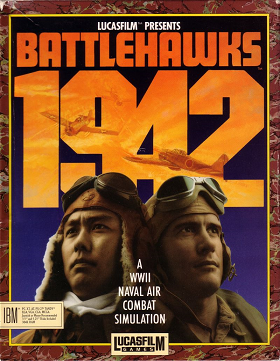Battlehawks 1942
| Battlehawks 1942 | |
|---|---|

PC cover art
|
|
| Developer(s) | Lucasfilm Games |
| Publisher(s) | Lucasfilm Games |
| Producer(s) | Noah Falstein |
| Designer(s) | Lawrence Holland |
| Programmer(s) | Lawrence Holland Michael Breen |
| Artist(s) |
Ken Macklin Martin Cameron |
| Writer(s) | Victor Cross Richard Halsey Best Noah Falstein |
| Platform(s) | MS-DOS, Amiga, Atari ST |
| Release | October 1988 |
| Genre(s) | Flight simulation |
| Mode(s) | Single player |
Battlehawks 1942 is a naval air combat flight simulation video game released in 1988 by LucasFilm Games. It is set in the World War II Pacific air war theatre, and was the first of Lucasfilm Games' trilogy of World War II flight simulations, followed by Their Finest Hour (1989) and Secret Weapons of the Luftwaffe (1991). The 127-page manual for Battlehawks 1942 includes a 100-page illustrated overview of the Pacific War.
In Battlehawks 1942, the player can participate in four pivotal naval battles of the Pacific war:
In each of these battles, the player can experience the same situation from the U.S. side or the Japanese side of the battle. The player can fly authentic aircraft of the era such as Grumman F4F Wildcats, Douglas SBD Dauntlesses and Grumman TBF Avengers on the U.S. side and Mitsubishi A6M Zeros, Aichi D3A "Vals" and Nakajima B5N "Kates" on the Japanese side. Realism settings such as invincibility, unlimited ammo and unlimited fuel, starting altitude and the caliber of the opposition pilots were present, so Battlehawks was customizable.
Each mission started with a briefing, giving the pilot a general outline of what was needed to do. In a departure from the usual flight-sim standards requiring players to perform take offs and landings, Battlehawks 1942 allowed players to get immediately into the action.
As with most flight simulators, Battlehawks has a cockpit view, switchable with the keypad for a look around the aircraft. Instruments are few: airspeed, altimeter, bank and pitch, fuel, rate-of-climb, RPM, compass and indicators for fuel and engine/airframe damage. The cockpit also had levers for landing gear, speed brakes (if equipped) and flaps.
The Battlehawks 1942 manual includes details Fighter Tactics instructions, such as deflection shooting or how to perform overhead approaches from the same or the opposite course. Mission types included escorting bombers as well as fighter interceptions, which were generally quite challenging and gave a great view of the diversity of the missions that were flown in the Pacific in 1942. Allied players flying Grumman F4F Wildcats would find themselves often vastly outnumbered in a desperate attempt to save their carriers from waves of Japanese Aichi D3A Val dive bombers.
...
Wikipedia
